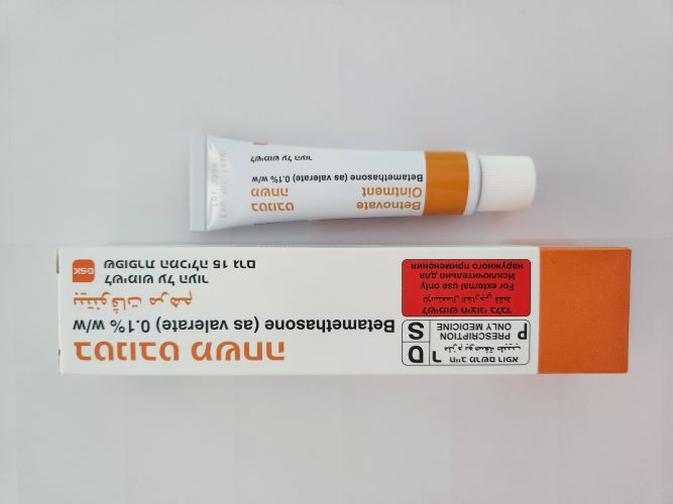Quest for the right Drug

בטנובט משחה BETNOVATE OINTMENT (BETAMETHASONE AS VALERATE)
תרופה במרשם
תרופה בסל
נרקוטיקה
ציטוטוקסיקה
צורת מתן:
עורי : DERMAL
צורת מינון:
משחה : OINTMENT
עלון לרופא
מינוניםPosology התוויות
Indications תופעות לוואי
Adverse reactions התוויות נגד
Contraindications אינטראקציות
Interactions מינון יתר
Overdose הריון/הנקה
Pregnancy & Lactation אוכלוסיות מיוחדות
Special populations תכונות פרמקולוגיות
Pharmacological properties מידע רוקחי
Pharmaceutical particulars אזהרת שימוש
Special Warning עלון לרופא
Physicians Leaflet
Special Warning : אזהרת שימוש
4.4 Special warnings and precautions for use Betamethasone valerate should be used with caution in patients with a history of local hypersensitivity to other corticosteroids. Local hypersensitivity reactions (see section 4.8) may resemble symptoms of the condition under treatment. Manifestations of hypercortisolism (Cushing’s syndrome) and reversible hypothalamic-pituitary-adrenal (HPA) axis suppression, leading to glucocorticosteroid insufficiency, can occur in some individuals as a result of increased systemic absorption of topical steroids. If either of the above are observed, withdraw the drug gradually by reducing the frequency of application, or by substituting a less potent corticosteroid. Abrupt withdrawal of treatment may result in glucocorticosteroid insufficiency (see section 4.8). Risk factors for increased systemic effects are: o Potency and formulation of topical steroid o Duration of exposure o Application to a large surface area o Use on occluded areas of skin e.g. on intertriginous areas or under occlusive dressings (in infants the nappy may act as an occlusive dressing) o Increasing hydration of the stratum corneum o Use on thin skin areas such as the face o Use on broken skin or other conditions where the skin barrier may be impaired o In comparison with adults, children may absorb proportionally larger amounts of topical corticosteroids and thus be more susceptible to systemic adverse effects. This is because children have an immature skin barrier and a greater surface area to body weight ratio compared with adults. Paediatric population In infants and children under 12 years of age, treatment courses should be limited to five days and occlusion should not be used; long-term continuous topical corticosteroid therapy should be avoided where possible, as adrenal suppression can occur. Infection risk with occlusion Bacterial infection is encouraged by the warm, moist conditions within skin folds or caused by occlusive dressings. When using occlusive dressings, the skin should be cleansed before a fresh dressing is applied. Use in Psoriasis Topical corticosteroids should be used with caution in psoriasis as rebound relapses, development of tolerances, risk of generalised pustular psoriasis and development of local or systemic toxicity due to impaired barrier function of the skin have been reported in some cases. If used in psoriasis careful patient supervision is important. Application to the face Prolonged application to the face is undesirable as this area is more susceptible to atrophic changes; therefore, treatment courses should be limited to five days and occlusion should not be used. Application to the eyelids If applied to the eyelids, care is needed to ensure that the preparation does not enter the eye, as cataract and glaucoma might result from repeated exposure. Visual disturbance Visual disturbance may be reported with systemic and topical corticosteroid use. If a patient presents with symptoms such as blurred vision or other visual disturbances, the patient should be considered for referral to an ophthalmologist for evaluation of possible causes which may include cataract, glaucoma or rare diseases such as central serous chorioretinopathy (CSCR) which have been reported after use of systemic and topical corticosteroids. Concomitant infection Appropriate antimicrobial therapy should be used whenever treating inflammatory lesions which have become infected. Any spread of infection requires withdrawal of topical corticosteroid therapy and administration of appropriate antimicrobial therapy. Chronic leg ulcers Topical corticosteroids are sometimes used to treat the dermatitis around chronic leg ulcers. However, this use may be associated with a higher occurrence of local hypersensitivity reactions and an increased risk of local infection. Flammability risk Product contains paraffin. Instruct patients not to smoke or go near naked flames due to the risk of severe burns. Fabric (clothing, bedding, dressings etc) that has been in contact with this product burns more easily and is a serious fire hazard. Washing clothing and bedding may reduce product build-up but not totally remove it. Topical steroid withdrawal syndrome Long term use of topical steroids can result in the development of rebound flares after stopping treatment (topical steroid withdrawal syndrome). A severe form of rebound flare can develop which takes the form of a dermatitis with intense redness, stinging and burning that can spread beyond the initial treatment area. It is more likely to occur when delicate skin sites such as the face and flexures are treated. Should there be a reoccurrence of the condition within days to weeks after successful treatment a withdrawal reaction should be suspected. Reapplication should be with caution and specialist advise is recommended in these cases or other treatment options should be considered.
Effects on Driving
4.7 Effects on ability to drive and use machines There have been no studies to investigate the effect of betamethasone valerate on driving performance or the ability to operate machinery. A detrimental effect on such activities would not be anticipated from the adverse reaction profile of topical betamethasone valerate.

שימוש לפי פנקס קופ''ח כללית 1994
Potent topical corticosteroid. Severe inflammatory skin disorders
תאריך הכללה מקורי בסל
01/01/1995
הגבלות
תרופה שאושרה לשימוש כללי בקופ'ח
מידע נוסף
עלון מידע לצרכן
10.12.17 - עלון לצרכן 12.12.17 - עלון לצרכן 02.09.21 - עלון לצרכן אנגלית 11.08.22 - עלון לצרכן עברית 02.09.21 - עלון לצרכן ערבית 19.10.22 - עלון לצרכן אנגלית 19.10.22 - עלון לצרכן עברית 19.10.22 - עלון לצרכן ערבית 05.06.23 - עלון לצרכן אנגלית 05.06.23 - עלון לצרכן עברית 08.06.23 - עלון לצרכן ערבית 01.10.24 - עלון לצרכן עברית 06.01.14 - החמרה לעלון 19.04.21 - החמרה לעלון 11.08.22 - החמרה לעלון 01.10.24 - החמרה לעלוןלתרופה במאגר משרד הבריאות
בטנובט משחה